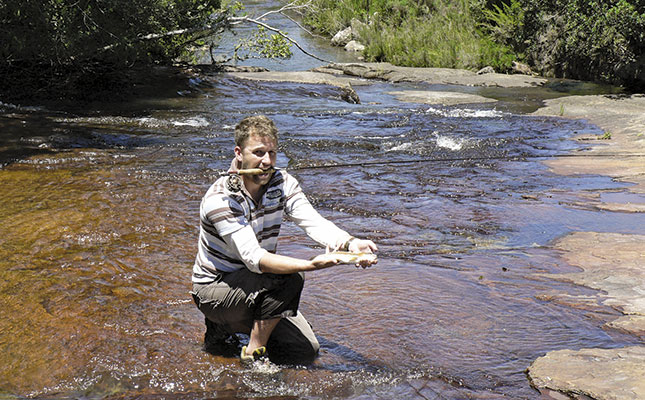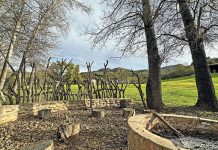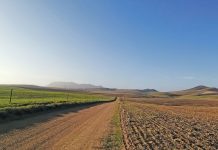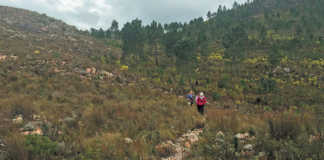
Sydney Hey’s fishing experiences in the Amatholes soon after the outbreak of the First World War in 1914 served as a catalyst to a lifelong passion for fly-fishing. His descriptions of the Wolf River and its trout in The Rapture of the River (first printed in 1957 and reprinted in 2006), made me yearn to visit this stream from the moment I read about it as a boy in my father’s copy of the book.
As it turned out, I was to travel up the Keiskamma River catchment several times as an adult in search of 19th century Frontier War sites before I eventually landed trout from the Wolf. And during this time, I learned that these fish owed their existence to the expansion of the British Empire.
Forgotten war
From the 1850s, when British and Cape Colonial forces began to take control of the Xhosa-ruled Amathole Mountains, British pastimes such as cricket, golf, rugby and fly-fishing began making an appearance in the area. So it’s not surprising that by the early 1900s, trout had come to the region’s streams to satisfy British tastes.
Today, the Wolf flows through the Amathole forests as it has for centuries.
Nowadays, however, it joins the Keiskamma River via the Sandile Dam, completed in 1983 under Ciskei Bantustan rule. The dam, named in honour of Sandile – who inherited the chieftainship of the Ngqika Xhosa and the paramountcy of the Rharhabe Xhosa in the early 1840s – swamped the site that played witness to a celebrated victory over the British in the eighth frontier War (1850-1853).
The Booma Pass (also spelt Boma) served as the gateway to the heart of the Amatholes, where by the 1860s, German settler communities had been established by the British. The rugged pass was feared because of its narrowness and the danger this could pose to troops trapped on it. Sure enough, on Christmas Eve 1850, the Xhosas – apparently under the command of Sandile – attacked a British force, leaving 12 dead.
By late 1853, a road through the infamous pass had been completed by the sixth Royal Regiment and the 60th Royal Rifles, only to be swallowed up by the Sandile Dam over a century later. All that is left is a memorial to those who served the British Empire to the end in a forgotten corner of Africa. Further down the Keiskamma River lies the grave of Chief Ngqika – father to Sandile – after whom the Ngqika Xhosa are named and who died in November 1829.
Located at the foot of the Amatholes near the site of the Free Church of Scotland Mission at Burnshill and the
historic site of the Great Place of Sandile, the grave was often passed by British and Colonial soldiers on their way to fight in the Amatholes further north. In April 1846, during the seventh Frontier War (1846-1847), a force under Colonel Henry Somerset camped at Burnshill before serious skirmishes led to the withdrawal of a three-mile long wagon supply train.
This was promptly attacked and looted by the Xhosas along the Keiskamma River between Fort Cox and Burnshill. Today, a pile of rocks on the banks reminds one of the incident while along the nearby road, a memorial immortalises the names of those who lost their lives to the Xhosas at places such as Burnshill, Fort Cox, Fort White, Debe Nek and Middledrift.
Wolf rainbows
I well remember my first visit to the Wolf River with my fishing buddy, Orrock Robertsen. After we had passed Sandile Dam, our 4×4 was halted by numerous dead ends on tracks in the dense indigenous forest. We were forced to approach the Wolf from the high grassland slopes to the east of Hogsback, and crossed the river over a tiny bridge.
While Orrock prepared lunch on the edge of the forest into which the Wolf disappeared, I sneaked along to the bridge pool with my rod. I managed to place a fly centimetres from where I had intended, and on my very first retrieve, my line tightened with a silver flash and I was fighting my first Wolf rainbow of about half-a-pound.
We followed the Wolf on its steep descent down the Amatholes along paths made by bushpigs. After a while, the steep, forested slopes became so demanding that we had to break our rods down and proceed on our backsides through thick bush occupied by an unpleasantly large population of black and yellow spiders.
Eventually, we broke through the forest into the cool waters of the Wolf and waded upstream, passing huge boulders to a spectacular waterfall pool, where we landed about 10 small rainbows. A short distance away, the Wolf disappeared over another cliff, and again we were forced to make our way around the obstacle by fighting through the bush, around huge tree trunks and outcrops of mushrooms.
We eventually broke through dense outcrops of ferns, moss-laden vines and bush to the Wolf, now flowing down steep smooth rocks to form the occasional pool. We passed several happy hours as we fought rainbows – a total of 16, with the best at about a pound – under the gaze of stately yellow woods and white stinkwood trees towering above the forest canopy.
The lure of fishing
As the sun began to set, we drank from yet another waterfall pool and rested as dusk approached. Here, we sat, no doubt mesmerised as Hey had been almost a century ago – a feeling of awe he captured in The Rapture of the River:
“We moved down to a pool, known as the waterfall pool, where the river poured over an almost perpendicular glide into a deep pool, fringed by tall overhanging trees on both banks. The rocks surrounding the pool were covered in maiden hair ferns, wherever these could find a hold, contributing to make as pretty a scene as it is possible to imagine.”
After scrambling back to our car, we drove out the Wolf valley in darkness and it was then that I was reminded of what has made Hey’s book universally appealing to fishermen. He captured what fishing was really about: an adventure in which fishing is a passionate excuse to embark on excursions to unique locations, in which, ever so often, one is rewarded with the exhilaration of landing a fish.
As for size, all fishermen love big fish, but oddly enough, those small trout of the Wolf will remain as memorable as the biggest fish I have ever landed, almost exclusively because of the experiences that led me to them.
Other sources include: www.tomsutcliffe.co.za; Terry Archer Holidays at Keiskamma Hoek; John Milton The Edges of War – A History of Frontier Wars (1702-1878); Noel Mostert Frontiers – The Epic of SA’s Creation and the Tragedy of the Xhosa People; The Frontier War Journal of Major John Crealock 1878 (Van Riebeeck Society Second Series, No. 19).












